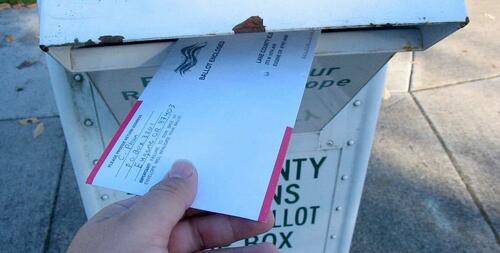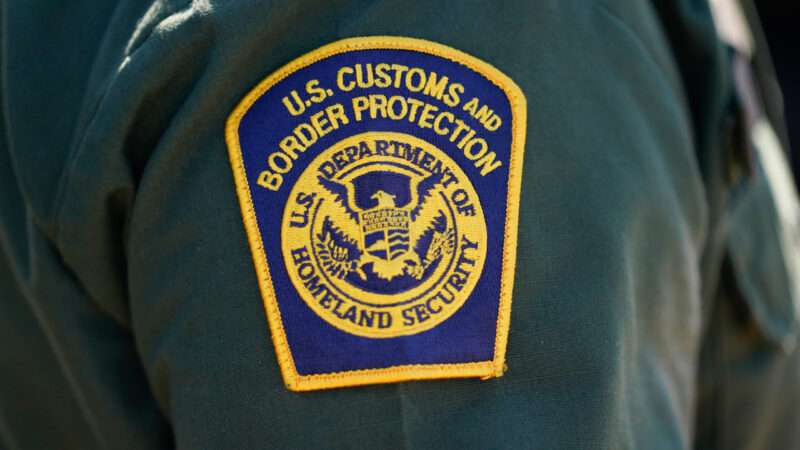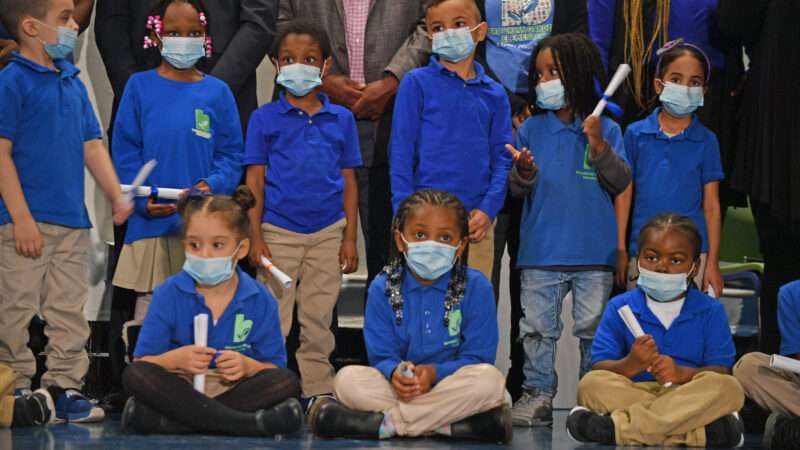This week, NBC News correspondent Heidi Przybyla tweeted a report about COVID-19 cases among public school students in Michigan. Her gloss implied that the data had just come out and that they revealed something important about the benefits of requiring students to wear face masks: “NEW: Virus spread was 62% higher in school districts without mask rules.”
The story that Przybyla cited was not actually “NEW.” It was published on October 15 by WJRT, the ABC station in Flint, based on data for August and September reported by researchers at the University of Michigan’s School of Public Health. Nor was the finding as meaningful as WJRT and Przybyla implied, since it did not take into account potentially important confounding variables such as vaccination rates and other precautions that districts with mask mandates may have adopted. Furthermore, the association between mask mandates and lower infection rates had faded by December.
When NPR media correspondent David Folkenflik pointed out that the finding highlighted by Przybyla was not new and had not held up over time, Przybyla, to her credit, acknowledged her mistake. But the episode highlighted how eager people who favor school mask mandates are to trumpet any evidence, no matter how iffy, that seems to support their preexisting policy preferences. That tendency extends to public health officials, including the director of the Centers for Disease Control and Prevention (CDC), who claim to be following the science but in this case are desperately searching for validation of a policy that was adopted without any firm empirical basis.
In an Atlantic article published this week, Margery Smelkinson, an infectious disease scientist who works for the National Institutes of Health, highlights the lack of evidence in favor of school mask mandates. “Two years into this pandemic, keeping unproven measures in place is no longer justifiable,” she and her co-authors write. “We reviewed a variety of studies—some conducted by the CDC itself, some cited by the CDC as evidence of masking effectiveness in a school setting, and others touted by media to the same end—to try to find evidence that would justify the CDC’s no-end-in-sight mask guidance for the very-low-risk pediatric population, particularly post-vaccination. We came up empty-handed.”
Vinay Prasad, an epidemiologist at the University of California, San Francisco, makes the same point more emphatically in a recent Tablet article. Forcing students to wear face masks “isn’t a matter of protecting children, their teachers, or their grandparents,” he says. “It’s delusional and dangerous cultlike behavior.”
That cult includes American Medical Association Chairman Bobby Mukkamala, who hyped the Michigan data that Przybyla highlighted this week. “This is a study exactly about this situation,” he told WJRT. “It doesn’t get more specific than this study, which is about kids in school with masks and without masks.”
Mukkamala presented the scientific case for school mask mandates as ironclad. “It’s one thing if it’s just sort of a gut feeling—well, you know, we think masks work, so why don’t we just go ahead and ask kids to wear them in school?” he said. “But this is way beyond that….This is data—one more study that shows the effectiveness, and not just masks in general, but particular to this situation.” He lamented that “there’s a deep division” over masks in schools that “isn’t necessarily data-driven.”
Mukkamala is right about that, but not in the way he means. Mask enthusiasts like Mukkamala and CDC Director Rochelle Walensky are the ones who are misrepresenting the science to validate their “gut feeling.”
The October 12 University of Michigan report that Mukkamala thought confirmed what he already believed noted that “districts with mask rules may also have other prevention measures that can contribute to lower transmission levels.” That consideration by itself means that no firm conclusion can be drawn about the impact of mask mandates: The association that so impressed Mukkamala could have been explained by “other prevention measures,” such as improved ventilation, physical distancing, or testing programs, rather than mask requirements.
Vaccination rates are another potential confounder, since it is plausible that they were higher in school districts that decided to require masks. Judging from places like New York City, California, and Washington, D.C., jurisdictions that adopt strict COVID-19 policies tend to have relatively high vaccination rates. And since the Michigan data reflect cases among school-aged children, as opposed to transmission in schools, it is not even clear to what extent district policies are relevant.
By December, in any event, case rates in Michigan school districts with mask requirements were about the same as case rates in school districts without them. “School-aged case rates have become more similar across mask rules as community transmission has increased,” a December 14 update noted. It suggested that “differences due to masking” were “potentially being washed out by transmission in other settings.” Nevertheless, “it remains important to mask up in indoor settings (schools and otherwise) to prevent transmission.”
When mask requirements were associated with lower case rates, that was touted as evidence that mask requirements work. But when mask requirements were no longer associated with lower case rates, that finding had no effect on the conviction that mask requirements are “important.” Evidently that belief “isn’t necessarily data-driven.”
The CDC has proceeded in the same manner. It recommends “universal indoor masking” for all children 2 or older, ranging from toddlers in day care to high school seniors. That advice is extreme by international standards.
“Many countries—the U.K., Sweden, Norway, Denmark, and others—have not taken the U.S.’s approach,” Smelkinson and her co-authors note, “and instead follow World Health Organization guidelines, which recommend against masking children ages 5 and younger, because this age group is at low risk of illness, because masks are not ‘in the overall interest of the child,’ and because many children are unable to wear masks properly. Even for children ages 6 to 11, the WHO does not routinely recommend masks, because of the ‘potential impact of wearing a mask on learning and psychosocial development.’ The WHO also explicitly counsels against masking children during physical activities, including running and jumping at the playground, so as not to compromise breathing.”
While the CDC does not insist on outdoor masking, some school districts do. “Many deep-blue areas such as Portland, Oregon; Los Angeles; and New York City have gone beyond CDC guidance and are masking students outdoors at recess,” Smelkinson et al. note, “in part because of byzantine rules that require an unmasked ‘exposed’ student to miss multiple days of school, even if the putative exposure is outside.”
At the point when the CDC began recommending universal masking in schools and day care centers, there was no solid evidence to support that policy. Most of the studies cited by the CDC did not even compare schools with mask mandates to schools without them. One exception was a study of Georgia elementary schools that found masking of teachers was associated with a statistically significant reduction in COVID-19 transmission, but masking of students was not.
A subsequent study considered “school-associated COVID-19 outbreaks” (rather than infection rates) in two Arizona counties. It found that outbreaks were less common in schools that mandated masks. But as Smelkinson et al. note, “more than 90 percent of schools in the ‘no mask mandate’ group were in Maricopa County, an area that has significantly lower vaccination rates than Pima County.” The study also did not control for other COVID-19 mitigation measures, and critics have pointed out various other weaknesses.
Another study looked at COVID-19 trends in about 3,000 counties with different school masking policies. It found that “counties without school mask requirements experienced larger increases in pediatric COVID-19 case rates after the start of school compared with counties that had school mask requirements.” But again, the study did not control for vaccination rates or other mitigation measures. And since “this was an ecologic study,” the researchers noted, “causation cannot be inferred.”
The usual way to address these problems is by conducting randomized, controlled trials. But no such studies of masking in schools have been conducted—a pretty striking omission for an intervention that affects millions of children across the country. Even for masking in general, there is a dearth of such evidence. While laboratory studies provide compelling evidence that masks—especially N95 respirators—can reduce virus transmission, it remains unclear what impact they have in real-world settings, where masks may not be clean, may not fit properly, and may not be worn correctly.
That uncertainty is compounded when mask requirements are imposed on children as young as 2, which may help explain why the purported benefits of school mask mandates have been so hard to verify. A preprint study based on data from Florida for the 2020–21 school year, for example, found no association between mask policies and case rates. Smelkinson et al. cite other data from Tennessee, Florida, North Dakota, and the U.K. that likewise are not consistent with the assumption that school mask mandates reduce virus transmission. Prasad notes that data from Spain also do not support that belief.
Prasad has long been skeptical that cloth masks—the kind most commonly used in schools—are effective in preventing COVID-19 transmission. That view has gained ground with the spread of the highly transmissible omicron variant. In light of omicron, CNN medical analyst Leana Wen, a former Baltimore health commissioner, declared last month, “cloth masks are little more than facial decorations.” Even the CDC has finally acknowledged that N95s “offer the highest level of protection,” while “loosely woven cloth products provide the least protection.”
Some schools have responded by mandating N95s or similar masks, which are more effective but also harder and more uncomfortable to wear properly, especially for children. But that escalation is hard to justify in light of several facts.
First, life-threatening COVID-19 symptoms have always been rare among children, and that is especially true of omicron infections, which tend to be less severe than cases caused by earlier variants. “A (pre-vaccine!) analysis from Germany shows that if a child is infected with COVID—with or without preexisting conditions—there is an 8 in 100,000 chance of going to the intensive care unit,” Prasad writes. “According to the same study, the risk of death is 3 in 1 million, with no deaths reported in the over-5 age group. These risks are astonishingly low.”
Second, vaccination, which is now available to anyone 5 or older, further reduces that already tiny risk. It also protects teachers and other adults who might catch COVID-19 from children.
Third, immunocompromised children and adults who might not gain the same benefit from vaccination can protect themselves from infection by wearing well-fitted N95s or similar masks even if students are not required to wear them. As Tufts Medical Center epidemiologist Shira Doron and two co-authors note in The Washington Post, “respirators and other high-quality masks are highly effective at protecting their wearers, regardless of what people around them are doing.” Doron et al. argue that the ready availability of high-quality masks means that “schools can finally safely make masks optional for students and staff.”
While the benefits of school mask mandates are uncertain at best, the burdens they impose are clear. In addition to the discomfort caused by wearing them all day, masks interfere with communication, learning, and social interaction.
“Recent prospective studies from Greece and Italy found evidence that masking is a barrier to speech recognition, hearing, and communication, and that masks impede children’s ability to decode facial expressions, dampening children’s perceived trustworthiness of faces,” Smelkinson et al. note. “Research has also suggested that hearing-impaired children have difficulty discerning individual sounds; opaque masks, of course, prevent lip-reading. Some teachers, parents, and speech pathologists have reported that masks can make learning difficult for some of America’s most vulnerable children, including those with cognitive delays, speech and hearing issues, and autism. Masks may also hinder language and speech development—especially important for students who do not speak English at home. Masks may impede emotion recognition, even in adults, but particularly in children.”
Given these serious concerns, the CDC’s inability to demonstrate the benefits of following its advice, or even to honestly discuss the relevant research, is an egregious failure. “When the history books are written, we will not look wise or kind for insisting that kids and toddlers wear masks for hours on end, year after year, without ever testing this policy with controlled trials,” Prasad concludes. “We will look ignorant, cruel, fearful, and cowardly. We might even look worse than our primitive ancestors who, when faced with great plagues, engaged in all sorts of bizarre, superstitious behavior—but which rarely included making kids suffer most.”
The post Why Can't the CDC Admit There Is No Solid Evidence To Support 'Universal Masking' in Schools? appeared first on Reason.com.
from Latest – Reason.com https://ift.tt/3uaS050
via IFTTT






